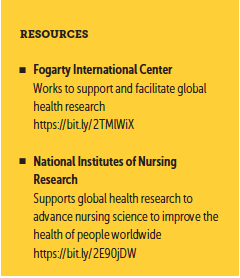How Does a Swedish Nursing Student View Clinical Oncology Care in the United States?
I have always been the type of person who wants to create the greatest good for the greatest number of people. This led me to an adventure that started in the fall of 2016 as I entered the Bachelor of Science in Nursing program at Hälsohögskolan (the School of Health Sciences) at Jönköping University in Sweden. A goal was set in the back of my mind that I wanted to study abroad in the United States and examine the similarities and differences between care provided in hospitals in the two different countries. For my independent study at the University of North Carolina (UNC) at Chapel Hill, I had the opportunity to take a deep dive into the area of nursing that interests me the most: adult oncology. Working closely with Ashley Leak Bryant, PhD, RN-BC, OCN®, my mentor in the UNC Chapel Hill School of Nursing, I was provided with several opportunities to learn about oncology nursing practice in the United States.
Jump to a section
I have always been the type of person who wants to create the greatest good for the greatest number of people. This led me to an adventure that started in the fall of 2016 as I entered the Bachelor of Science in Nursing program at Hälsohögskolan (the School of Health Sciences) at Jönköping University in Sweden. A goal was set in the back of my mind that I wanted to study abroad in the United States and examine the similarities and differences between care provided in hospitals in the two different countries. For my independent study at the University of North Carolina (UNC) at Chapel Hill, I had the opportunity to take a deep dive into the area of nursing that interests me the most: adult oncology. Working closely with Ashley Leak Bryant, PhD, RN-BC, OCN®, my mentor in the UNC Chapel Hill School of Nursing, I was provided with several opportunities to learn about oncology nursing practice in the United States.
After joining the Oncology Nursing Society as a student member, I participated in the Cancer Basics online course to gain a better understanding of all the components that encompass that dreaded word: cancer. The course had a variety of topics, including the definition and pathophysiology of cancer, the management of symptoms, patient enrollment and eligibility in clinical trials, and the future of cancer care. I found that the self-directed modules helped me establish a foundation of information about cancer and oncology nursing care.
Once I completed the Cancer Basics course, I spent three days observing different aspects of cancer care at the North Carolina Cancer Hospital. My first shadowing experience was on the 53-bed inpatient medical oncology unit with private rooms. I was amazed by how frequently the nurses used communication tools like Situation, Background, Assessment, Recommendation (SBAR) to report any patient updates or changes to members of the interprofessional team. Another tool I had not seen used in Sweden was the bedside nurse report. This was employed by the incoming and outgoing nurses to communicate with one another about patients, as well as to check IV fluids, verify that fall precautions were in place, and perform other important safety checks. I was also struck by the use of tools and technologies geared toward medication safety, including everything from nurse identification badges, to passwords, to fingerprints used to access the medication dispensing system. Patients’ wristbands were even scanned before medication administration. My hope is to use similar tools and technologies in the near future in Sweden.
My second shadowing experience was in the adult infusion clinic, where I was able to see how the interprofessional team works to provide the best care to patients. I also followed patients and their caregivers through treatments and talked to them about their cancer journeys. I observed two bone marrow biopsies that were intended to determine whether the treatment was working well. During the first biopsy, thoughts about how long the patient might have left to live started to fill up the room, and I could see the fear in her eyes. The second biopsy was done to make sure that the patient was in remission. Seeing and hearing her joy and happiness for this day brought tears to my eyes. These are two different stories with two different outcomes, for the patients and for myself. As a nursing student, I feel that this was so valuable to see, and the experiences made me fall in love with oncology care even more.
My third shadowing experience took place with the palliative care nurse practitioner (NP) on the palliative care team. I observed how the NP communicates with the patient and family about relief of symptoms and goals of care. From this experience, I better understand the importance of and need for palliative care across the cancer trajectory.
I am so thankful for this opportunity and could not be happier with how kind, helpful, and warm all the members of the cancer team were in their willingness to share their knowledge. All I can say is that I have found my passion and plan to work in oncology nursing, and I am so glad that I said yes to this learning adventure. 
About the Author(s)
Sofia Anarp is a senior undergraduate student in Hälsohögskolan (the School of Health Sciences) at Jönköping University in Sweden, who spent the fall semester of 2018 in the School of Nursing at the University of North Carolina at Chapel Hill. Anarp can be reached at sofia.anarp@gmail.com, with copy to CJONEditor@ons.org.




